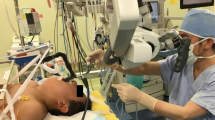Abstract
Pyriform sinus fistulas are an unusual cause of neck cystic lesions in neonates. A definitive diagnosis requires detection of the fistula, which originates from the pyriform sinus and extends to the cystic lesion. Sonography has been reported to be useful for detecting fistulas. However, there have been no reports of neonatal cases in which sonography could detect fistulas not detected by other modalities, such as barium esophagography, computed tomography (CT), or magnetic resonance imaging (MRI). We describe five neonatal patients with pyriform sinus fistula-appearing cervical cystic lesions. All patients were examined by sonography; of these, three patients were also examined by barium esophagography, two by CT, and one by MRI. The fistula was detected by sonography but not CT in one patient and by barium esophagography but not MRI in one. Two patients whose fistulas were detected by sonography had an oval-shaped and relatively small cystic lesion. One patient whose fistula could be detected only by barium esophagography had a relatively large cystic lesion. In two patients, whose fistulas were not detected by sonography or barium esophagography, sonography revealed air bubbles within the cystic lesions, and a pyriform sinus fistula was suspected. Without requiring ionizing radiation, sonography was thus useful in diagnosing pyriform sinus fistula-appearing cervical cystic lesions in neonatal cases. On the other hand, in two patients whose fistulas were not detected by sonography, the shape of the cystic lesion was polygonal or multicystic. In two of three patients with infectious signs, a fistula could not be detected. The shape and size of the cystic lesion and the presence of infectious signs may be important factors for detecting fistulas.





Similar content being viewed by others
References
Ohno KA. Case of pyriform sinus fistula. Jpn J Pediatr Surg 1989;25:96–103 (in Japanese with English abstract).
Amano H. Differences in the characteristics and management of pyriform sinus fistula between neonates and young children. Pediatr Surg Int. 2012;28:15–20.
de Buys Roessingh AS. Obstructive neonatal respiratory distress: infected pyriform sinus cyst. J Pediatr Surg. 2008;43:E5–8.
Mizuno R. Pyriform sinus fistula appearing as a neck tumor in the neonatal period: a case report. Pediatr Surg Int. 1998;14:82–3.
Sheng Q. Diagnosis and management of pyriform sinus fistula: experience in 48 cases. J Pediatr Surg. 2014;49:455–9.
Gan YU. Imaging findings in acute neck infection due to pyriform sinus fistula. Ann Acad Med Singap. 2004;33:636–40.
Wang HK. Imaging studies of pyriform sinus fistula. Pediatr Radiol. 2003;33:328–33.
Liberman M. Ten years of experience with third and fourth branchial remnants. J Pediatr Surg. 2002;37:685–90.
Liu Z. Diagnosis of pyriform sinus fistula in children via ultrasonography. Am J Otolaryngol. 2013;34:579–81.
Ahuja AT. The role of ultrasound and oesophagography in the management of acute suppurative thyroiditis in children associated with congenital pyriform fossa sinus. Clin Radiol. 1998;53:209–11.
Yanai T. Suspicion of prenatal pyriform sinus cyst and fistula: a case report. Pediatr Surg Int. 2004;20:58–60.
Tyler D. Pyriform sinus cyst and fistula in the newborn: the value of endoscopic cannulation. J Pediatr Surg. 1992;27:1500–1.
Miyauchi A. Piriform sinus fistula. A route of infection in acute suppurative thyroiditis. Arch Surg. 1981;116:66–9.
Macpherson RI. Gastrointestinal tract duplications: clinical, pathologic, etiologic and radiographic considerations. Radiographics. 1993;13:1063–80.
Castellote A. Cervicothoracic lesions in infants and children. Radiographics. 1999;19:583–600.
Davidson AJ. Mature teratoma of the retroperitoneum: radiologic, pathologic, and clinical correlation. Radiology. 1989;172:421–5.
Conflict of interest
Takahiro Hosokawa, Yoshitake Yamada, Yumiko Sato, Yutaka Tanami, Hizuru Amano, Michimasa Fujiogi, Hiroshi Kawashima, and Eiji Oguma declare that they have no conflict of interest.
Ethical consideration
This article does not contain any studies with human subjects performed by any of the authors.
Author information
Authors and Affiliations
Corresponding author
About this article
Cite this article
Hosokawa, T., Yamada, Y., Sato, Y. et al. Five neonatal cases of pyriform sinus fistula with cervical cystic lesion: a comparison between sonography and other modalities. J Med Ultrasonics 42, 579–585 (2015). https://doi.org/10.1007/s10396-015-0641-5
Received:
Accepted:
Published:
Issue Date:
DOI: https://doi.org/10.1007/s10396-015-0641-5




